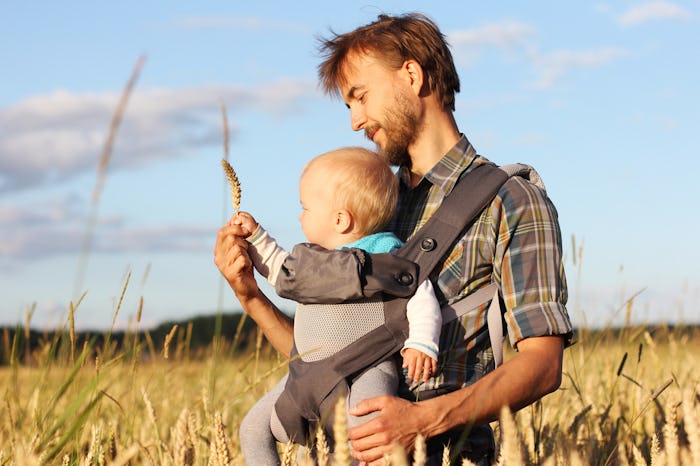Life

Here's When Your Baby's Ready To Start Facing Forward In A Carrier
I’m a huge fan of babywearing and plan to follow the practice once my baby arrives. To me, babywearing seems like a great way to help you develop a close bond, all while having your hands free to do stuff, like write articles, which is what I’m hoping to be able to do while wearing my baby (fingers crossed). But how long do I have until I need to turn my baby around and potentially risk him “helping” me with my articles? When can you put a baby facing forward in a carrier?
There's a pretty easy answer — wait to turn your baby around in their carrier to see the world until about four months after their due date, says Dr. S. Daniel Ganjian, a pediatrician at Providence Saint John’s Health Center in Santa Monica, California. “Wait until your child's neck muscles are developed and can move his head against gravity … Premature babies that are born one month early have to wait until five months, and those born two months early have to wait until six months,” Ganjian explains in an email interview with Romper. “Some babies do not develop good muscle control until a later time because of developmental delay. If your child's neck is still floppy even at 4 to 5 months, then do not change to forward-facing, and contact your pediatrician to assess your child's development.”
It’s important to wait for good neck muscle control because of babies’ large heads, compared to the rest of their bodies at least. If you don’t wait, Ganjian says, “The large head can tilt forward (chin to chest position), closing the baby's airway. If the infant has good head control, he can lift his head up by himself, significantly decreasing the risk of suffocation (which can happen in one to two minutes). If your child has a cold or other causes of difficulty breathing, monitor his breathing even more closely [when babywearing].”
As far as the type of carrier you use, it doesn’t change the fact that you need to wait until their necks are strong enough to support their heads, because even the firmer structure “cannot completely prevent the infant's neck from flexing, causing the chin to go to the chest and decrease breathing,” Ganjian says.
However, there are different benefits to each a wrap and sturdy carrier. Ganjian explains, “Children communicate through different routes: Speech, eye contact, and smell. One of the biggest ways of communication is through touch. Since touch-communication is so important, hospitals are encouraging skin-to-skin contact from birth, where the child is placed on the mother's chest (or even father's chest when mother can't).” That’s why the wrap is so great, because it allows the parent to “touch their child at all times,” he says. “Babies love it because of the warmth, smell, and the sounds of the heart beating, reminding them of their serene voyage in the womb.” And even in a sturdy carrier, your baby will love to look at you because “eye contact allows for a stronger relationship and the development of social skills." Plus, with your hands free, you can do more activities. “Furthermore, I encourage parents to use their stroller in the position that allows for their child to look at them,” says Ganjian.
The downsides to your baby’s health when it comes to babywearing aren't from the product itself, but if you don’t do it correctly. “If your child has a cold or other causes of difficulty breathing, monitor his breathing even more closely. Furthermore, make sure the hips are flexed and are not in a straight position to decrease the chances of developmental hip dysplasia,” Ganjian explains. He also warns against driving a car, riding a bike, or drinking hot drinks while babywearing. “Be careful when bending over — bend with your knees and not your back to prevent falls and muscle strain of the parent's back."
There are definitely quite a few “pros” when it comes to babywearing, just make sure to wait until your baby is at least 4 months old and able to hold their head up properly before turning them around to face the world. In the meantime, enjoy those snuggles and bonding time with your new baby.
Check out Romper's new video series, Bearing The Motherload, where disagreeing parents from different sides of an issue sit down with a mediator and talk about how to support (and not judge) each other’s parenting perspectives. New episodes air Mondays on Facebook.